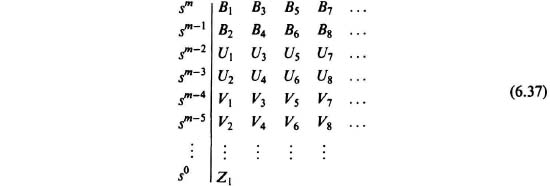6.3. ROUTH—HURWITZ STABILITY CRITERION
The Routh–Hurwitz stability criterion is an algebraic procedure for determining whether a polynomial has any zeros in the right half-plane. It involves examining the signs and magnitudes of the coefficients of the characteristic equation without actually having to determine its roots. This method does not indicate the relative degree of stability or instability.
Routh [3] and Hurwitz [4] independently determined the necessary and sufficient conditions for stability from the signs and magnitudes of the coefficients of the characteristic equation. A useful form of their approach is described below.
Let us represent the general form of the characteristic equation by
![]()
If a coefficient is negative or zero when at least one of the other coefficients is positive, then a root exists which is in the right half-plane or is imaginary. For this case, the system is unstable and one can stop here. If all the coefficients are present, real, and positive, then the coefficients are arranged in two rows:
![]()
We obtain additional rows of coefficients from these two rows as follows:

where
This pattern will continue until all the terms in a row are zero. The rows are ...
Get Modern Control System Theory and Design, 2nd Edition now with the O’Reilly learning platform.
O’Reilly members experience books, live events, courses curated by job role, and more from O’Reilly and nearly 200 top publishers.

